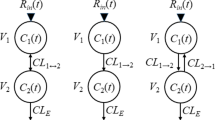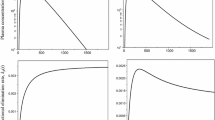Abstract
Numerical methods have been used to compare the availability predictions of a number of hepatic elimination models when Michaelis-Menten kinetics is operative. Propranolol and galactose were used as model compounds. Lower availabilities were predicted by the dispersion model than by a segregated distribution model for both compounds. The differences in the predictions were most pronounced for models corresponding to a large variation in solute residence times in the liver. The predictions of the tank-in-series, dispersion model with mixed boundary conditions and dispersion model with Dankwerts boundary conditions were similar over all concentrations studied. Changes in blood flow and protein binding provided little discrimination between the model predictions. It is concluded that micromixing of blood between sinusoids and the anatomical sites of mixing are important determinants of availability when liver eliminating enzymes are partially saturated.
Similar content being viewed by others
Abbreviations
- A:
-
Cross-sectional area
- C:
-
Concentration
- C :
-
Concentration normalized to input concentration
- CV 2 :
-
Normalized variance
- ĉ :
-
Logarithmic mean concentration
- CL int :
-
Intrinsic clearance
- DN :
-
Dispersion number
- f(t) :
-
Output concentration-time profile after a bolus input
- F:
-
Availability
- fu :
-
Fraction unbound
- g(L):
-
Distribution of tube lengths function
- G(t) :
-
Cumulative (total) fraction of dose leaving liver
- k(c) :
-
Rate estimation constant per unit volume
- K m :
-
Michaelis constant
- L :
-
Length of liver
- n :
-
Number of tanks
- P:
-
Permeability of hepatocyte to drug
- Q:
-
Blood flow rate
- R N :
-
Efficiency number
- t :
-
Time
- ¯t :
-
Mean residence time
- T :
-
Dimensionless time (=t/¯t)
- ν :
-
Mean blood velocity
- V :
-
Volume or volume of distribution
- Vmax :
-
Maximum velocity
- z :
-
Distance within liver
- Z :
-
Fractional distance within liver (z/L)
- b :
-
based on measurement in blood
- c:
-
based on measurement in cell
- in:
-
input
- out:
-
exit
- o −2 :
-
Variance
- ρ :
-
Axial variation in enzyme activity
- ∂:
-
Partial derivative
- ∝ :
-
Fraction of sinusoids in a given class
References
M. S. Roberts and M. Rowland. Hepatic elimination — dispersion model.J. Pharm. Sci. 74:585–587 (1985).
K. S. Pang and M. Rowland. Hepatic clearance of drugs. 1. Theoretical considerations of a well-stirred model and a parallel-tube model. Influence of hepatic blood flow, plasma and blood cell binding and hepatocellular enzymatic activity on hepatic drug clearance.J. Pharmacokin. Biopharm. 5:625–653 (1977).
L. Bass, P. J. Robinson, and A. J. Bracken. Hepatic elimination of flowing substances: The distributed model.J. Theor. Biol. 72:161–184 (1978).
M. S. Roberts and M. Rowland. A dispersion model of hepatic elimination. 1. Formulation of the model and bolus considerations.J. Pharmacokin. Biopharm. 14:227–260 (1986).
M. S. Roberts and M. Rowland. A dispersion model of hepatic elimination. 2. Steady-state considerations. Influence of blood flow, protein binding and hepatocellular enzymatic activity.J. Pharmacokin. Biopharm. 4:261–288 (1986).
M. S. Roberts and M. Rowland. A dispersion model of hepatic elimination. 3. Application to metabolite formation and elimination kinetics.J. Pharmacokin. Biopharm. 14:289–307 (1986).
A. B. Ahmad, P. N. Bennett, and M. Rowland. Models of hepatic drug clearance: Discrimination between the well-stirred and parallel-tube models.J. Pharm. Pharmacol. 35: 219–224 (1983).
D. B. Jones, D. J. Morgan, G. W. Mihaly, L. K. Webster, and R. A. Smallwood. Discrimination between the venous equilibrium and sinusoidal models of hepatic drug elimination in the isolated perfused rat liver by perturbation of propranolol protein binding.J. Pharmacol. Exp. Ther. 229: 522–526 (1984).
M. Rowland, D. Leitch, G. Fleming, and B. Smith. Protein binding and hepatic clearance: Distribution between models of hepatic clearance with diazepam, a drug of high intrinsic clearance, in the isolated perfused rat liver preparation.J. Pharmacokin. Biopharm. 12: 129–147 (1984).
K. S. Pang and J. R. Gillette. Kinetics of metabolite formation and elimination in the perfused rat liver preparation: Differences between the elimination of preformed acetaminophen and acetaminophen formed from phenacetin.J Pharmacol. Exp. Ther. 207:178–194 (1978).
K. S. Pang and M. Rowland. Hepatic clearance of drugs. III. Additional experimental evidence supporting the well-stirred model, using metabolite (MEGX) generated from lidocaine under varying hepatic blood flow rates and linear conditions in the perfused liver in situ preparation.J. Pharmacokin. Biopharm. 5:681–699 (1977).
M. S. Roberts and M. Rowland. Correlation between in-vitro microsomal enzyme activity and whole organ hepatic elimination kinetics: Analysis with a dispersion model.J. Pharm. Pharmacol. 38:117–181 (1986).
L. Bass. Flow dependence of first-order uptake of substances by heterogeneous perfused organs.J. Theor. Biol. 86:365–376 (1980).
L. Bass, M. S. Roberts, and P. J. Robinson. On the relation between extended forms of the sinusoidal perfusion and of the convection-dispersion models of hepatic elimination.J. Theor. Biol. 126: 457–482 (1987).
M. S. Roberts, J. D. Donaldson, and M. Rowland. Models of hepatic elimination: Comparison of stochastic models to describe residence time distribution and to predict the influence of drug distribution, enzyme heterogeneity and systemic recycling on hepatic elimination.J. Pharmacokin. Biopharm. 16: 41–84 (1988).
J. J. Gumucio and D. L. Miller. Functional implications of liver cell heterogeneity.Gastroenterology 60:393–402 (1981).
S. Keiding and K. Priisholm. Current models of hepatic pharmacokinetics: Flow effects on kinetic constants of ethanol elimination in perfused rat liver.Biopharm. Pharmacol. 33: 3209–3312 (1984).
S. Keiding and E. Chiarantini. Effect of sinusoidal perfusion on galactose elimination in perfused rat liver.J. Pharmacol. Exp. Ther. 205:465–470 (1978).
S. Keiding and E. Steiness. Flow dependence of propranolol elimination in perfused rat liver.J. Pharmacol. Exp. Ther. 230:474–477 (1984).
E. L. Forker and B. Luxon. Hepatic transport kinetics and plasma disappearance curves: Distributed modelling versus conventional approach.Am. J. Physiol. 235:E648-E660 (1978).
O. Levenspeil.Chemical Reaction Engineering J. Wiley and Sons, New York, 1976, pp. 253–315.
R. A. Weisiger. Dissociation from albumin: A potentially rate-limiting step in the clearance of substances by the liver.Proc. Natl. Acad. Sci. USA 82:1563–1567 (1985).
R. A. Weisiger, C. M. Mendel, and R. C. Cavalieri. The hepatic sinusoid is not well-stirred. Estimation of the degree of axial mixing by analysis of lobular concentration gradients formed during uptake of thyroxine by the perfused rat liver.J. Pharm. Sci. 75: 233–237 (1986).
K. S. Pang and R. N. Stillwell. An understanding of the role of enzyme localisation of the liver on metabolite kinetics: A computer simulation.J. Pharmacokin. Biopharm. 11:451–468 (1983).
K. S. Pang, J. A. Terrell, S. D. Nelson, K. F. Feuer, M. Clements, and L. Edrenyi. Later enzyme heterogeneity. An enzyme-distributed system for lidocaine metabolism in the perfused rat liver preparation.J. Pharmacokin. Biopharm. 14:107–130 (1986).
D. G. Shand and J. A. Oates. Metabolism of propranolol by rat liver microsomes and its inhibition by phenothiazone and tricyclic antidepressant drugs.Biochem. Pharmacol. 20:1720–1723 (1971).
A. Rane, G. R. Wilkinson, and D. G. Shand. Prediction of hepatic extraction ratio from in vitro measurement of intrinsic clearance.J. Pharmacol. Exp. Ther. 200:420–424 (1977).
G. Dalquist, A. Bjorck, and N. Anderson.Numerical Methods, Prentice Hall, Englewood Cliffs, N.J., 1974.
C. A. Goresky. A linear method for determining liver sinsuoidal and extravascular volumes.Am. J. Physiol. 204:626–640 (1963).
C. A. Goresky, G. G. Bach, and B. E. Nadeau. On the uptake of materials by the intact liver: The concentrative transport of rubidum-86.J. Clin. Invest. 52:975–990 (1973).
C. A. Goresky, G. G. Bach, and B. E. Nadeau. On the uptake of materials by the intact liver: The transport and net removal of galactose.J. Clin. Invest. 52:991–1009 (1973).
C. A. Goresky. Kinetic interpretation of hepatic multiple indicator dilution studies.Am. J. Physiol. 245:G1-G12 (1983).
C. A. Goresky, E. R. Gordon, and G. G. Bach. Uptake of monohydric alcohols by liver: Demonstration of a shared enzymatic space.Am. J. Physiol. 244:G198-G214 (1983).
G. F. Froment and K. B. Bischoff.Chemical Reactor Analysis and Design, Wiley, New York, 1979, pp. 592–661.
L. Bass and S. Keiding. Physiologically based models and strategic experiments in hepatic pharmoacology.Biochem. Pharmacol. 37:1425–1431 (1988).
L. Bass. Saturation kinetics in hepatic drug removal: A statistical approach to functional heterogeneity.Am. J. Physiol. 244:G583-G589 (1983).
K. S. Pang and J. A. Terrell. Retrograde perfusion to probe the heterogeneous distribution of hepatic drug metabolising enzymes in rats.J. Pharmacol. Exp. Ther. 216:339–346 (1981).
H. Vilstrup, S. Keiding, and P. B. Vendsborg. Kinetics of galactose uptake by perfused rat livers: Applicability of a family of models.J. Theor. Biol. 101:335-335–344 (1983).
Y. Sawada, Y. Sugiyama, Y. Miyamoto, T. Iga, and M. Hanano. Hepatic drug clearance model: comparison among the distributed, parallel tube and well-stirred models.Chem. Pharm. Bull. 33:319–326 (1985).
E. L. Forker and B. A. Luxon. Hepatic transport kinetics: Effect of anatomic and metabolic heterogeneity on estimates of the average transfer coefficients.Am. J. Physiol. 243:G532-G540 (1982).
S. Miyauchi, T. Sugiyama, Y. Sawada, K. Morita, T. Iga, and M. Hanano. Kinetics of hepatic transport of 4-methylumbelliferone in rats. Analysis by multiple indicator dilution method.J. Pharmacokin. Biopharm. 15:25–38 (1987).
A. Koo, I. Y. S. Liang, and K. K. Cheng. The terminal hepatic microcirculation in the rat.Q. J. Exp. Physiol. 60:261–266 (1975).
P. J. Robinson, L. Bass, S. M. Pond, M. S. Roberts, and J. G. Wagner. Clinical applicability of current pharmacokinetic models: Splanchnic elimination of 5-fluorouracil in cancer patients.J. Pharmacokin. Biopharm. 16:229–249 (1988).
Author information
Authors and Affiliations
Additional information
One of us (M.S.R.) wishes to thank the National Health and Medical Research Council of Australia (NHMRC) and the Dean's Fund (MRC, NZ).
Rights and permissions
About this article
Cite this article
Roberts, M.S., Donaldson, J.D. & Jackett, D. Availability predictions by hepatic elimination models for Michaelis-Menten kinetics. Journal of Pharmacokinetics and Biopharmaceutics 17, 687–719 (1989). https://doi.org/10.1007/BF01062125
Received:
Revised:
Published:
Issue Date:
DOI: https://doi.org/10.1007/BF01062125




